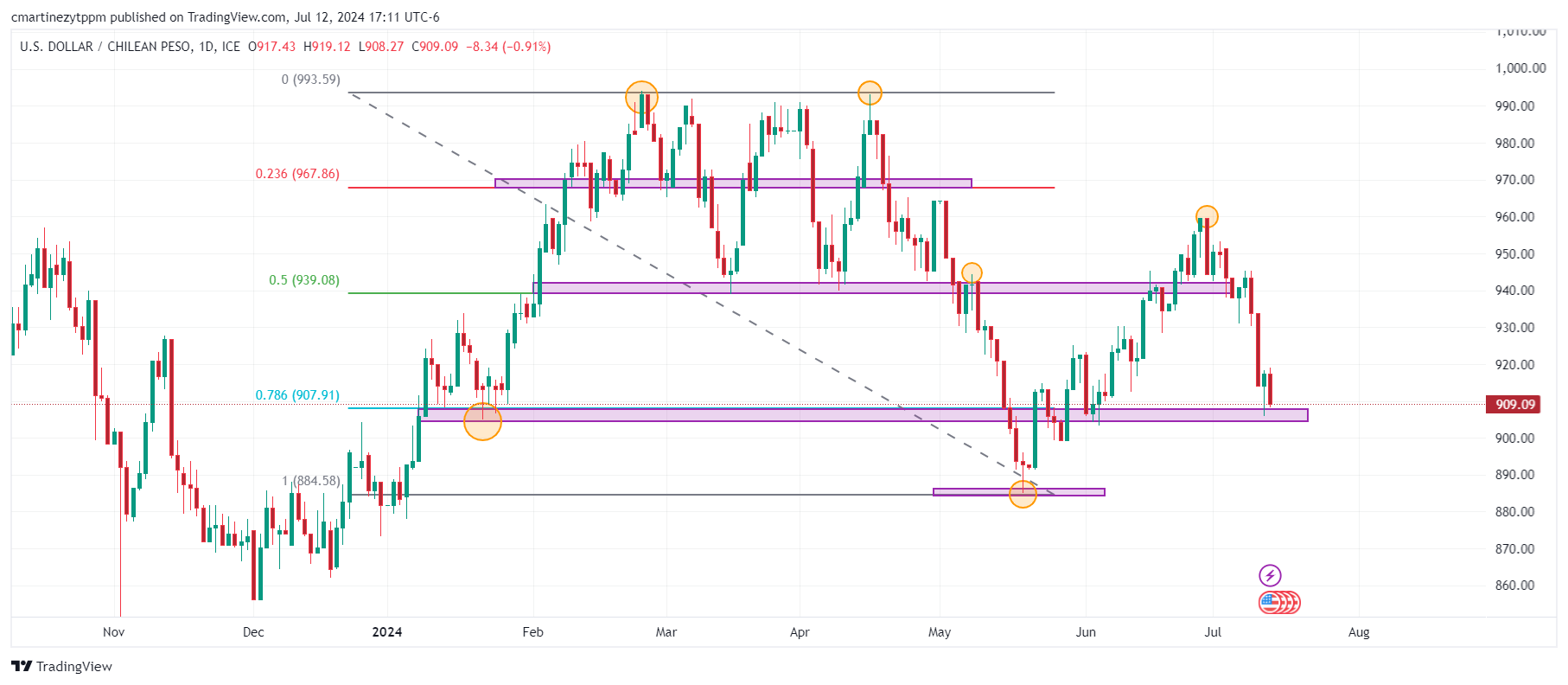- The USD/CLP fell 0.91% today.
- China’s trade balance records a surplus of 99.05 B in June.
- Investors will focus on China’s GDP, which is expected to decline to 5.1% in June, according to consensus.
The USD/CLP recorded a daily high at 919.12, finding sellers who pushed the pair to a daily low of 908.27. At the close of the American session, the price of the US Dollar against the Chilean Peso is trading at 909.09, losing 0.91%, in today’s session.
Chilean Peso Rebounds Following Economic Data from China
The recent depreciation of the dollar has boosted emerging market currencies, as the likelihood of a rate cut in September increases.
The General Administration of Customs of the People’s Republic of China released its Trade Balance for the month of June, recording a surplus of $99.05 B, exceeding the $85 B expected by the market and the previous $82.62 B in May.
It is worth noting that exports increased by 8.6% in June, up from 7.6% in May. On the other hand, imports fell by 2.3% in the same month, well below the 2.8% expected by analysts.
Investors will be keeping an eye on China’s gross domestic product, due out on July 14. Expectations are for second-quarter growth of 5.1%, down from the previous reading of 5.3% in the previous quarter.
Technical levels in the USD/CLP
The USD/CLP has settled at a first support located at 907.30 which converges with the 78.6% Fibonacci retracement. The next support is at 885.00, the low of May 20. The closest resistance is at 892.38, the high of June 27.
Chilean Peso Daily Chart

US Dollar FAQs
The United States Dollar (USD) is the official currency of the United States of America, and the de facto currency of a significant number of other countries where it is in circulation alongside local banknotes. As of 2022, it is the most traded currency in the world, accounting for over 88% of all global foreign exchange transactions, equivalent to an average of $6.6 trillion in daily transactions. Following World War II, the USD took over from the British Pound as the world’s reserve currency.
The single most important factor influencing the value of the US dollar is monetary policy, which is determined by the Federal Reserve (Fed). The Fed has two mandates: to achieve price stability (control inflation) and to promote full employment. Its main tool for achieving these two goals is to adjust interest rates. When prices rise too quickly and inflation exceeds the Fed’s 2% target, the Fed raises rates, which helps the dollar. When inflation falls below 2% or the unemployment rate is too high, the Fed can lower interest rates, which weighs on the dollar.
In extreme situations, the Federal Reserve can also print more dollars and enact quantitative easing (QE). QE is the process by which the Fed substantially increases the flow of credit in a jammed financial system. It is an unconventional policy measure used when credit has dried up because banks are not lending to each other (for fear of counterparty default). It is a last resort when simply lowering interest rates is unlikely to achieve the necessary result. It was the Fed’s weapon of choice to combat the credit crunch that occurred during the Great Financial Crisis of 2008. It involves the Fed printing more dollars and using them to buy US government bonds, primarily from financial institutions. QE typically leads to a weakening of the US dollar.
Quantitative tightening (QT) is the reverse process whereby the Federal Reserve stops buying bonds from financial institutions and does not reinvest the principal of maturing securities in new purchases. It is generally positive for the US dollar.
Source: Fx Street
I am Joshua Winder, a senior-level journalist and editor at World Stock Market. I specialize in covering news related to the stock market and economic trends. With more than 8 years of experience in this field, I have become an expert in financial reporting.







